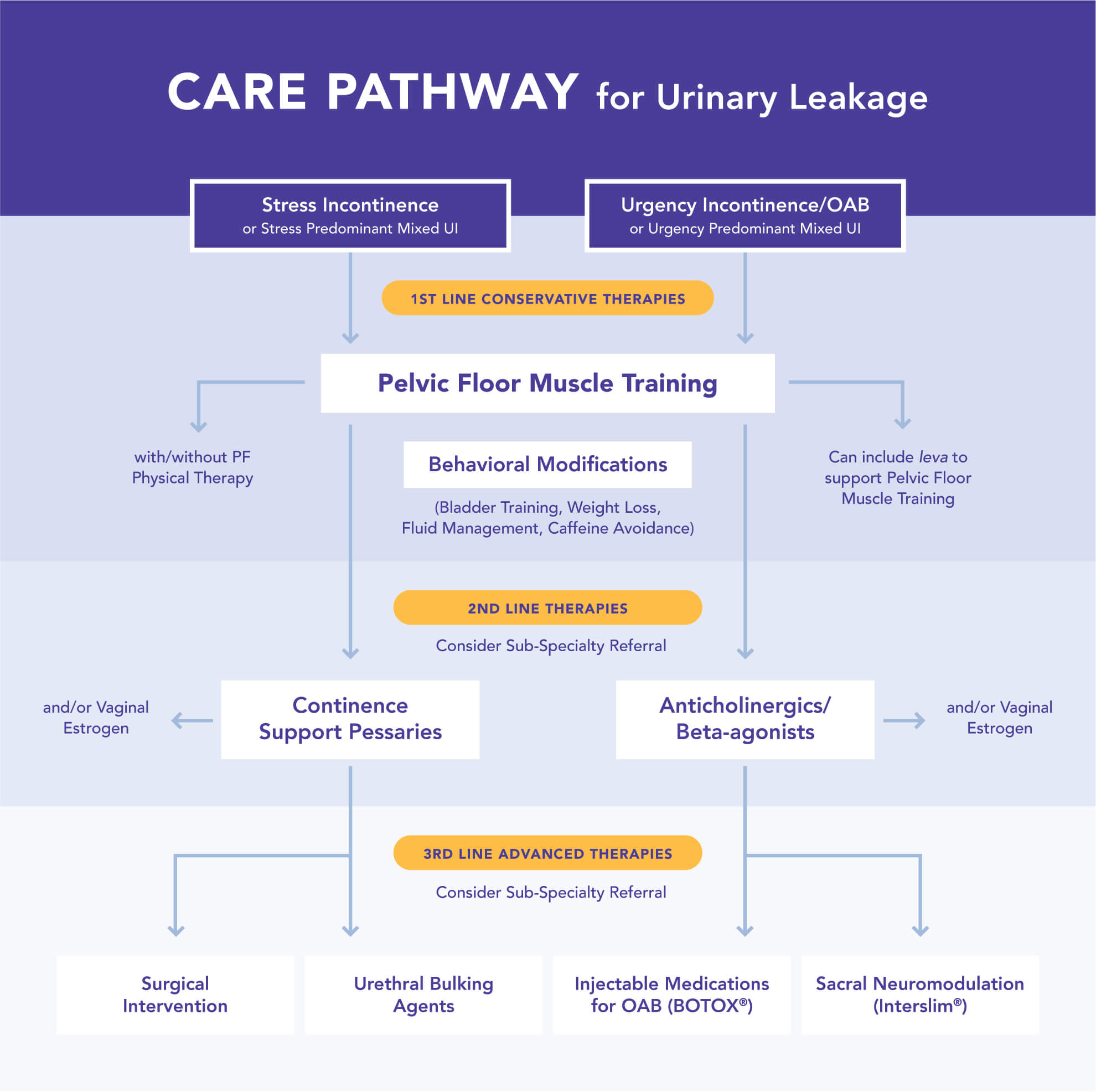Get the facts about UI
UI is a serious and often progressive condition, ranging from occasional leaks when coughing or sneezing to the complete inability to control the bladder. While it is more common in older women, it is not a normal consequence of aging.

Causes of incontinence
UI can be by caused by weakened pelvic floor muscles, often due to the following.
3 main types of UI address by pelvic floor muscle training
Stress urinary incontinence (SUI)
An involuntary loss of urine when coughing, laughing or sneezing. Leaks can also happen during sporting activities or other physical exertion.
Mild to moderate urgency urinary incontinence (UUI), including overactive bladder (OAB). UUI is a sudden, strong, often uncontrollable, urge to urinate. Women with UUI may leak urine on the way to the bathroom. OAB is a constellation of symptoms including urgency, frequency and nocturia.
Mixed urinary incontinence (MUI)
This type includes symptoms of both stress and urgency incontinence
Care pathway for urinary leakage
Treating patients for UI can begin with first-line therapy in the form of pelvic floor muscle training. Learn more about treatment options.

Over 60% of U.S. women experience UI1
As few as 25% of women with UI seek treatment from their healthcare professional2
Women with UI are at a 30% greater risk of hospitalization7
Women with UI are 2x as likely to be admitted to a nursing facility7
How pelvic floor muscle training can be used to treat UI
Help your patients take control of their pelvic health.
Contact our Provider Support Helpline to learn more.
Contact UsReferences
- Patel UJ, Godecker AL, Giles DL, Brown HW. Updated Prevalence of Urinary Incontinence in Women: 2015-2018 National Population-Based Survey Data [published online ahead of print, 2022 Jan 12]. Female Pelvic Med Reconstr Surg. 2022;10.1097/SPV.0000000000001127. doi:10.1097/SPV.0000000000001127.
- Minassian VA, Yan X, Lichtenfeld MJ, Sun H, Stewart WF. The iceberg of health care utilization in women with urinary inconti¬nence. Int Urogynecol J. 2012;23(8):1087-1093.
- Erekson E, Hagan KA, Austin A, et al. Outpatient Evaluation and Management Visits for Urinary Incontinence in Older Women. J Urol. 2019;202(2):333-338.
- Waetjen LE, Xing G, Johnson WO, Melnikow J, Gold EB; Study of Women’s Health Across the Nation (SWAN). Factors associated with reasons incontinent midlife women report for not seeking urinary incontinence treatment over 9 years across the menopausal transition. Menopause. 2018;25(1):29-37.
- Favre-Inhofer A, Dewaele P, Millet P, Deffieux X. Systematic review of guidelines for urinary incontinence in women. J Gynecol Obstet Hum Reprod. 2020;49(8):101842. doi:10.1016/j.jogoh.2020.101842.
- Moen MD, Noone MB, Vassallo BJ, Elser DM. Pelvic floor muscle function in women presenting with pelvic floor disorders. Int Urogynecol J. 2009;20(7):843-846. doi:10.1007/s00192-009-0853-6.
- Thom DH, Haan MN, Van Den Eeden SK. Medically recognized urinary incontinence and risks of hospitalization, nursing home admission and mortality. Age and Ageing. 1997;26(5):367-374. doi:10.1093/ageing/26.5.367.
Important Safety Information
The Leva® Pelvic Health System is intended for: (i) strengthening of the pelvic floor muscles; (ii) rehabilitation and training of weak pelvic floor muscles for the treatment of stress, mixed and mild to moderate urgency urinary incontinence (including overactive bladder) in women; and (iii) rehabilitation and training of weak pelvic floor muscles for the first-line treatment of chronic fecal incontinence (>3-month uncontrolled passage of feces) in women. This product interacts with the user via smartphone technology.
Important Safety Information for the Leva Pelvic Health System: Do not share the Leva system. Leva is a single-user medical device. Do not use the Leva Pelvic Health System while pregnant, or if you think you may be pregnant, unless authorized by your healthcare provider. Do not leave the Leva vaginal wand in your body for longer than necessary to complete the training session. Remove the vaginal wand after each training session. Do not use the Leva Pelvic Health System in any other place in your body. Do not have sexual intercourse while the vaginal wand is inserted. If you experience odor, fever, vomiting, diarrhea, any signs of infections or any flu-like symptoms, contact your doctor immediately. If you experience redness or swelling near the insertion area, or signs of an allergic reaction, contact your healthcare provider immediately For a complete summary of the risks and instructions for the Leva System, see its Instructions for Use available at www.levatherapy.com. Treatment with the Leva Pelvic Health System is prescribed by your healthcare provider. This treatment is not for everyone. Please talk to your healthcare provider to see if it is right for you. Your healthcare provider should discuss all potential benefits and risks with you.
Limited Warranty
Axena Health warrants the leva® Pelvic Health System (“leva” or the “device”) against defects in materials and workmanship for six (6) months from the date of original purchase. Alleged defects must be reported to Axena Health by the original purchaser prior to the end of the warranty. Warranty claims must be supported with reasonable evidence of the claimed defect. Axena Health may require the device be returned and if required, will provide customer with a Return Material Authorization number, which must be displayed on the outside packaging sent to Axena Health.
Axena Healthreserves the right to determine whether to repair or replace a device determined to be defective. In the event of replacement, the warranty period of the replacement device will be run from the date of the original purchase. Repair or replacement of your device will not extend the time period of this limited warranty.
This limited warranty does not cover cosmetic or battery deterioration or damage caused by excessive wear and tear, physical or natural destruction, accident, misuse, neglect or other external causes. Any attempt to disassemble the device will invalidate this limited warranty and any use of the device that is contrary to its Instructions for Use (available on Axena Health ’s website) may invalidate this limited warranty.
REPAIR OR REPLACEMENT OF THE DEVICE OR ITS AFFECTED COMPONENT ARE THE EXCLUSIVE REMEDIES PROVIDED IN CONJUNCTION WITH THE PURCHASE AND USE OF THE DEVICE. TO THE EXTENT PERMITTED BY LAW, THIS WARRANTY AND THE REMEDIES SET FORTH ARE EXCLUSIVE AND IN LIEU OF ALL OTHER WARRANTIES, REMEDIES AND CONDITIONS, WHETHER ORAL, WRITTEN, STATUTORY, EXPRESS OR IMPLIED. AXENA HEALTH DISCLAIMS ALL STATUTORY AND IMPLIED WARRANTIES, INCLUDING WITHOUT LIMITATION, WARRANTIES OF MERCHANTABILITY AND FITNESS FOR A PARTICULAR PURPOSE AND WARRANTIES AGAINST HIDDEN OR LATENT DEFECTS. IN SO FAR AS SUCH WARRANTIES CANNOT BE DISCLAIMED, AXENA HEALTH LIMITS THE DURATION AND REMEDIES OF SUCH WARRANTIES TO THE DURATION OF THIS EXPRESS WARRANTY AND, AT AXENA HEALTH ’S OPTION, REPAIR OR REPLACEMENT AS DESCRIBED ABOVE. SOME STATES DO NOT ALLOW CERTAIN WARRANTY LIMITATIONS, SO THE LIMITATION DESCRIBED ABOVE MAY NOT APPLY TO YOU.
Please contact Axena Healthto confirm the terms of this Limited Warranty prior to purchase. Axena Healthreserves the right, at its discretion, to modify its terms at any time prior to your purchase.

